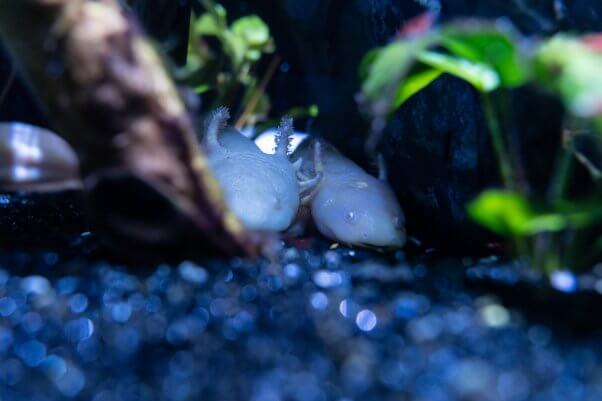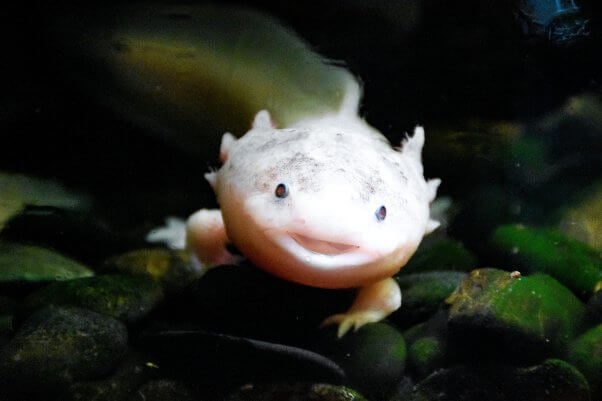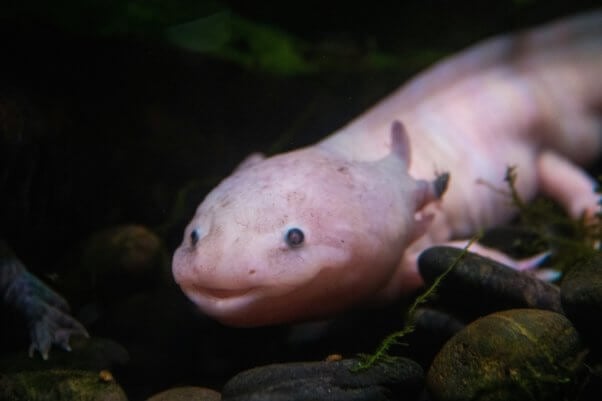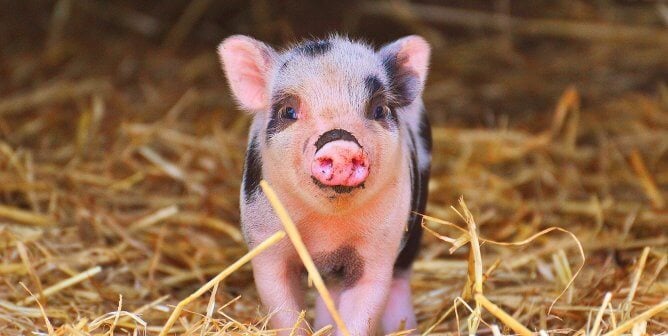Facts About Axolotls
Axolotls are known for their delicate gills, curious eyes, and remarkable regenerative abilities. Learn more about axolotls and how you can help them!
Get to know these amazing animals with these axolotl facts:

Axolotls Can Regenerate Body Parts
Did you know that axolotls can regenerate most of their body parts, including limbs and major organs like the heart, brain, and lungs? They can also camouflage themselves to blend into their surroundings to avoid predators!
Most amphibians, such as frogs, transform from tadpoles, who live in the water, into adults, who spend time on land and in the water. But axolotls keep their juvenile features for their entire lives, skipping metamorphosis altogether. This lifelong retention of juvenile traits is known as neoteny.
Did you know? Due to axolotls’ regenerative abilities, experimenters seek them out and conduct meaningless tests on them, cutting off their limbs in attempts to learn about tissue regeneration. In these experiments, laboratory staff cut into, injure, or manipulate axolotls’ bodies and observe how they heal, all in environments that cause stress. Laboratory workers have bred axolotls in captivity since 1864, yet the supposed benefits of experimenting on them in order to develop treatments for humans are still uncertain.
Axolotls Are Great Communicators
Instead of using verbal communication, axolotls rely on subtle visual and chemical cues to navigate their social scene. Although these animals are mostly solitary, their personalities vary from one individual to another. Some axolotls are more active and playful when they’re younger.
During their mating season (typically in February), axolotls who’ve reached the age of sexual maturity, around 1 year old, engage in some specific behaviors. Males perform a courtship ritual called the “hula” dance, shaking their tails and lower bodies to attract females, who respond with a gentle nudge of their snout.
Fun Fact: “Axolotl” is from the Nahuatl language spoken by the Nahua peoples who are indigenous to the region now known as central Mexico.
Axolotls Are Native to Mexico
Axolotls are native to Lake Xochimilco and Lake Chalco in Mexico and thrive in freshwater. In nature, axolotls can live for 10 to 15 years.

In laboratories, some experimenters force metamorphosis in axolotls by adding iodine to their environment or administering thyroid hormones. This leads to severe stress, health issues, and early death. Most axolotls die within one to two years after forced metamorphosis because it’s not a natural part of their life cycle.
Axolotls Are Endangered
While they are abundant in captivity due to the pet trade and laboratory experiments, axolotls are critically endangered due to fishing, rising temperatures resulting from the human-caused climate catastrophe, urbanization, and the spread of invasive species. This imbalance is troubling, as they play a crucial role in maintaining the aquatic food chain by preying on smaller organisms. Removing axolotls from their ecosystem disrupts this balance and contributes to their decline.
How Is the Pet Trade Exploiting Axolotls?
The pet trade is a living hell for axolotls because their regenerative abilities are exploited for profit. Breeders create hybrid axolotls, like “fireflies,” with a two-tone appearance by surgically swapping and mismatching their tails, which is a cruel and unethical practice. This manipulation results in Frankenstein-like individuals and prioritizes humans’ aesthetic preferences over the animals’ well-being.

Axolotls Do NOT Make Good ‘Pets’
Should you keep an axolotl as a “pet”? No!
These sensitive individuals require specific conditions that are difficult and expensive to maintain in captivity. They need cool water temperatures, minimal light exposure, and gentle water flow, which necessitates specialized tank filters and frequent water changes. Handling them is also a big no-no, as it can damage their delicate slime-skin barrier, making them susceptible to infections.
The popularity of TikTok videos of “pet” axolotls, fueled by their prevalence in games like Minecraft, has led to suffering for many of these animals, as they’re popular with children, who lack the resources or knowledge to care for them properly. It’s critical to leave axolotls in their natural habitats because when they’re kept in captivity as “pets,” they can experience significant stress due to improper living conditions, lack of space, or poor care, which can lead to illness, weakened immunity, and death.
How to Help Axolotls
By advocating for their right to live in nature, we can help axolotls remain in the ecosystems that depend on them and prevent their abuse in captivity.
If you come across axolotls for sale, don’t purchase them. Instead, spread awareness about the harmfulness of buying axolotls as “pets” and educate sellers about how damaging it is to sell them. Encourage others never to buy animals. Your actions can contribute to protecting axolotls and making sure they stay where they belong—in their natural habitats.
Be mindful of the products you buy. Only support cruelty-free and vegan brands to ensure that you’re not funding experiments on animals or the use of animals as “ingredients.” Every choice you make can help protect animals and create a more compassionate world.
With millions of homeless animals in U.S. animal shelters, “responsible breeding” is a myth. If someone is making money from selling an axolotl or any other animal, their priority isn’t animals’ well-being. Together, we can end the cycle of breeding and exploitation in the pet trade.




